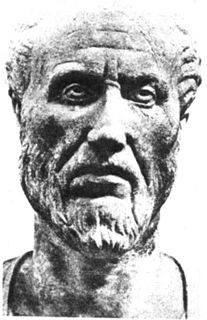 W
WThe Apology of Aristides was written by the early Christian writer Aristides. Until 1878, our knowledge of Aristides was confined to some references in works by Eusebius of Caesarea and Saint Jerome. Eusebius said that he was an Athenian philosopher and that Aristides and another apologist, Quadratus, delivered their Apologies directly to the Emperor Hadrian. Aristides is also credited with a sermon on Luke 23:43. Aristides remained a philosopher after his conversion to Christianity, and he continued to work as a philosopher in Athens.
 W
WBabrius, also known as Babrias (Βαβρίας) or Gabrias (Γαβρίας), was the author of a collection of Greek fables, many of which are known today as Aesop's Fables.
 W
WThe Chaldean Oracles are a set of spiritual and philosophical texts widely used by Neoplatonist philosophers from the 3rd to the 6th century CE. While the original texts have been lost, they have survived in the form of fragments consisting mainly of quotes and commentary by Neoplatonist writers. They were likely to have originally formed a single mystery-poem, which may have been in part compiled, in part received via trance, by Julian the Chaldean, or more likely, his son, Julian the Theurgist in the 2nd century CE. Later Neoplatonists, such as Iamblichus and Proclus, rated them highly. The 4th-century emperor Julian suggests in his Hymn to the Magna Mater that he was an initiate of the God of the Seven Rays, and was an adept of its teachings. When Christian Church Fathers or other Late Antiquity writers credit "the Chaldeans", they are probably referring to this tradition.
 W
WAgainst Celsus, preserved entirely in Greek, is a major apologetics work by the Church Father Origen of Alexandria, written in around 248 AD, countering the writings of Celsus, a pagan philosopher and controversialist who had written a scathing attack on Christianity in his treatise Logos Alēthēs. Among a variety of other charges, Celsus had denounced many Christian doctrines as irrational and criticized Christians themselves as uneducated, deluded, unpatriotic, close-minded towards reason, and too accepting of sinners. He had accused Jesus of performing his miracles using black magic rather than actual divine powers and of plagiarizing his teachings from Plato. Celsus had warned that Christianity itself was drawing people away from traditional religion and claimed that its growth would lead to a collapse of traditional, conservative values.
 W
WIn Classical mythology, Crocus was a mortal youth who was changed by the gods into a saffron flower.
 W
WThe Deipnosophistae is an early 3rd-century AD Greek work by the Greek author Athenaeus of Naucratis. It is a long work of literary, historical, and antiquarian references set in Rome at a series of banquets held by the protagonist Publius Livius Larensis for an assembly of grammarians, lexicographers, jurists, musicians, and hangers-on. It is sometimes called the oldest surviving cookbook.
 W
WThe Greek Anthology is a collection of poems, mostly epigrams, that span the Classical and Byzantine periods of Greek literature. Most of the material of the Greek Anthology comes from two manuscripts, the Palatine Anthology of the 10th century and the Anthology of Planudes of the 14th century.
 W
WThe New Testament (NT) is the second division of the Christian biblical canon. It discusses the teachings and person of Jesus, as well as events in first-century Christianity. The New Testament's background, the first division of the Christian Bible, is called the Old Testament, which is based primarily upon the Hebrew Bible; together they are regarded as sacred scripture by Christians.
 W
WThe Palatine Anthology, sometimes abbreviated AP, is the collection of Greek poems and epigrams discovered in 1606 in the Palatine Library in Heidelberg. It is based on the lost collection of Constantinus Cephalas of the 10th century, which in turn is based on older anthologies. It contains material from the 7th century BC until 600 AD and later on was the main part of the Greek Anthology which also included the Anthology of Planudes and more material.
 W
WThe Second Apocalypse of John is a Greek Christian text sometimes classified as among the New Testament apocrypha. It is falsely attributed to John of Patmos. Its date is uncertain and has been placed as early as the late fourth century and as late as the mid-ninth.